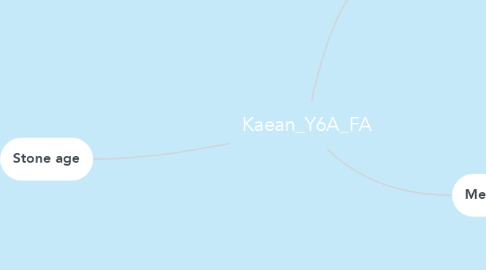
1. Stone age
1.1. Palaeolithic
1.1.1. The Chinese Palaeolithic age began around 3.000.000 years ago and ended around 10.000 years ago. The evolution of mankind from apes beginning with the Homo Erectus, the Homo Sapiens (which only evolved in africa but spreaded influence globally), and ended with the late Homo Sapiens. Modern humans can be recognized by their lighter form of their skeletons compared to earlier humans. Moden humans have larger brains rather than the earlier humans and its average size is around 1300 cubic centimeters. Keeping the brain in the skull requires a thin walled, high vaulted skull along with a flat and near vertical forehead. An average face of a modern human has heavy brow ridges and prognathism of some early humans but not every modern human has this body characteristic and our jaws don't develop well compared to our ancestors because we have smaller and weaker teeth so it is easier for our ancestors to probably eat raw and fresh meat. Fire at that time was also widely used to cook food and to provide warmth to the person/group who uses it. The social system in groups commonly have the mother as the head of the group/family. The famous discoveries of China's prehistoric times are probably the 'Hetao man' who lived around 500.000-300.000 years ago which was digged up in Nothern China's inner Mongolia, Liujiang whose remains were discovered in Liuzhou two hours away from Guilin, located in South China's Guangxi province the 'Zhiyu man' the caveman was found who lived around 300.000 years ago in caves. The level of human productivity was drastically improved in the Palaeolithic age such as primitive farming, stock keeping and more tools emerged and humans started to settle down in organized residences.
1.2. Neolithic
1.2.1. The Chinese Neolithic age had a different social system/hierarchy which men/males were the primary figures and the leaders so a new system is formed. Labour and work was essential and were widely used than the previous times which created agricultural improvement, the new technique of creating ceramics and silk products and labour social divisions. Patriarchal families started to form around the Neolithic age and it basically means a community ruled by men including the hearts of the family. The things of the father's side can only be inherited by the male members lineage of the family including property and money (because at that time, the Chinese became more advanced than their ancestors from the Palaeolithic age). Chinese Neolithic age culture mostly includes social hierarchies and traditional values. The first one is the Peiligang Culture 裴李岗文化. It existed from around 7000 to 5000 BC which widely influenced the Yellow river located in Henan province, central China is the oldest Neolithic culture. The culture focused on practising agricultural activities which increased the amount of livestock supplies (mostly food). The people hunted animals and fished for carp by the lake regularly and they have seperate residential and burial areas. It is mostly known for being the very first culture to have made and used pottery. Then, we have the Cishan Culture 磁山文化. The Cishan culture was a given name to a Neolithic community discovered in Cishan in North China's Hebei province. The culture existed from 5400 to 5100 BC. Some similar things discovered between the Cishan and the Peiligang culture is how they practised agricultural activities in the form of millet. People at that time started to use more of tools and rely more on them and some of the tools who made big impact is are stone sickles. knives, and shovels as their main tools for agricultural activities and pottery practises and creations made by hand. Then the Yangshao Culture 仰韶文化. The culture refers to a community which existed in the Neolithic age found around the middle stretch of the Yellow River from the Gansun province to Hainan province in which existed from around 5000 to 3000 BC. The Yangshao culture was firstly discovered in 1921 by a Swedish archaeologist by the name of Johan Gunnar Andersson. More than 1000 remains of the Yangshao culture was successfully found mostly in North China's province of Shaanxi. The Banpo site located in the Yellow River Valley was one of the most important sites of Neolithic history ever. Much of pottery and stone tools were discovered at the site. There is a museum built there the Banpo museum to house and display the discovered remains although less popular than the Terracota army museum and the Shaanxi History Museum.

